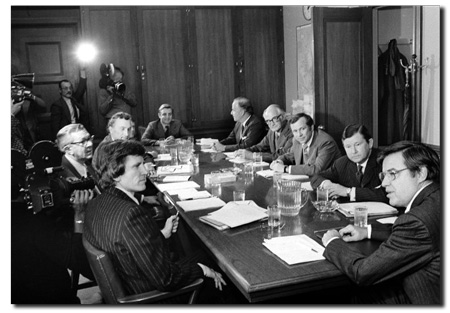Since we currently live in an age where digital privacy (and thus, for most of us, essentially all privacy) is really non-existent, I thought it would be interesting to figure out the precedent for government data collection and mass surveillance.
Mass surveillance and information security is a point of huge contention and controversy, especially today (see coronavirus trackers, facial recognition, etc.). Although I thought I previously understood the true power of government surveillance, after researching these four parts of my blog, I suspect that we will never have real privacy in the future. I think Senator Frank Church (which I will mention later in this post) said it best: “If this government ever became a tyrant, if a dictator ever took charge in this country, the technological capacity that the intelligence community has given the government could enable it to impose total tyranny, and there would be no way to fight back because the most careful effort to combine together in resistance to the government, no matter how privately it was done, is within the reach of the government to know.”
Perhaps the best effort I see for any semblance of true privacy are new encryption techniques to approach perfect encryption, but the government is even trying to break that (see the EARN IT act and backdoors).
Perhaps the best effort I see for any semblance of true privacy are new encryption techniques to approach perfect encryption, but the government is even trying to break that (see the EARN IT act and backdoors).
Now, enough with the introduction, here’s some history.
One of the largest early surveillance programs was ECHELON, which is operated by five countries known as the “Five Eyes”: the United States, the United Kingdom, Australia, Canada, and New Zealand. The program originated from a mutual security agreement called the UKUSA Agreement. Originally, in 1943, it was just the BRUSA Agreement, which stated that both countries would share intelligence information with each other. This was obviously extremely important in World War II, as cracking codes to uncover enemy plans and intercepting communications was a key part of the Allies war efforts. At the beginning of the Cold War, Britain and the United States shared information on the Soviet Union and the Eastern European countries. Australia, Canada, and New Zealand would all join the UKUSA agreement during this time.
One of the largest early surveillance programs was ECHELON, which is operated by five countries known as the “Five Eyes”: the United States, the United Kingdom, Australia, Canada, and New Zealand. The program originated from a mutual security agreement called the UKUSA Agreement. Originally, in 1943, it was just the BRUSA Agreement, which stated that both countries would share intelligence information with each other. This was obviously extremely important in World War II, as cracking codes to uncover enemy plans and intercepting communications was a key part of the Allies war efforts. At the beginning of the Cold War, Britain and the United States shared information on the Soviet Union and the Eastern European countries. Australia, Canada, and New Zealand would all join the UKUSA agreement during this time.
 ECHELON was mainly used in the 1960s to monitor the communications of the Soviet Union to gain an edge in the Cold War. As we learned in class, the Space Race and launching of satellites into orbit enabled people to communicate through these satellites. The Five Eyes started to place listening stations around the globe. The concept behind these stations was to intercept satellite transmissions, no matter where they were coming from or going. The replacement of satellites with fiber optics as the primary center for data transfer would lead to modern surveillance programs.
ECHELON was mainly used in the 1960s to monitor the communications of the Soviet Union to gain an edge in the Cold War. As we learned in class, the Space Race and launching of satellites into orbit enabled people to communicate through these satellites. The Five Eyes started to place listening stations around the globe. The concept behind these stations was to intercept satellite transmissions, no matter where they were coming from or going. The replacement of satellites with fiber optics as the primary center for data transfer would lead to modern surveillance programs.  In 1975, the Church Committee of the Senate (chaired by Frank Church) investigated the NSA. One of the largest revelations was the presence of Operation Shamrock, which was the collection of all telegrams entering and exiting the United States. Even without a warrant, telegrams could be printed at any time. Another related surveillance operation was Project MINARET, which targeted specific Americans on a list and collected messages sent and received by them. Many activists were targeted, including people from the Civil Rights Movement such as MLK Jr. and anti-Vietnam War protesters.
In 1975, the Church Committee of the Senate (chaired by Frank Church) investigated the NSA. One of the largest revelations was the presence of Operation Shamrock, which was the collection of all telegrams entering and exiting the United States. Even without a warrant, telegrams could be printed at any time. Another related surveillance operation was Project MINARET, which targeted specific Americans on a list and collected messages sent and received by them. Many activists were targeted, including people from the Civil Rights Movement such as MLK Jr. and anti-Vietnam War protesters.
These investigations would lead to the passing of the Foreign Intelligence Surveillance Act of 1978 in an attempt to prevent future bureaucratic abuses of power. Read on in the next part for more information.
Sources:
No comments:
Post a Comment
Note: Only a member of this blog may post a comment.